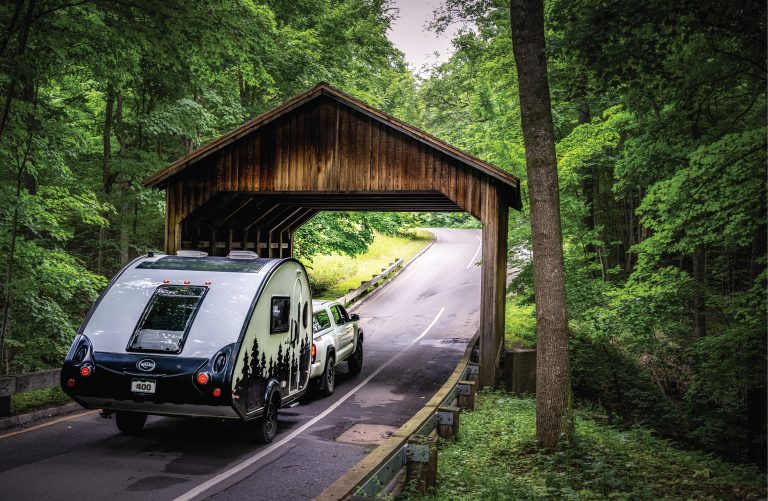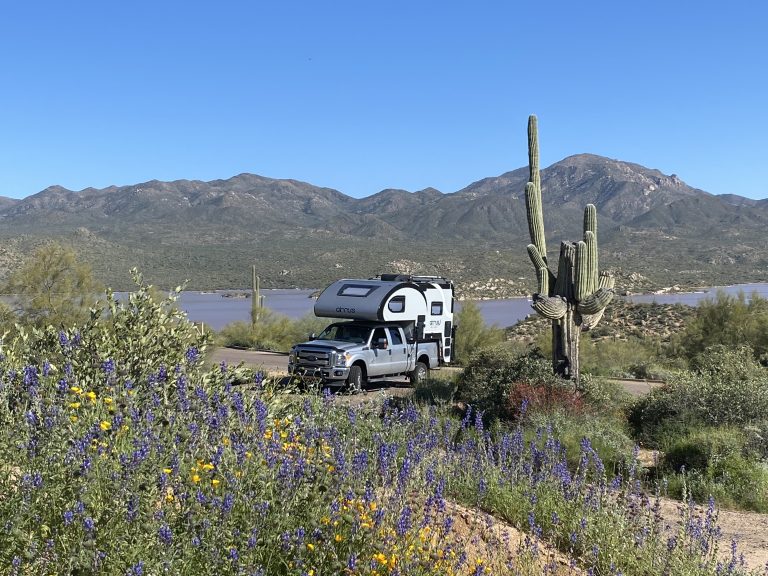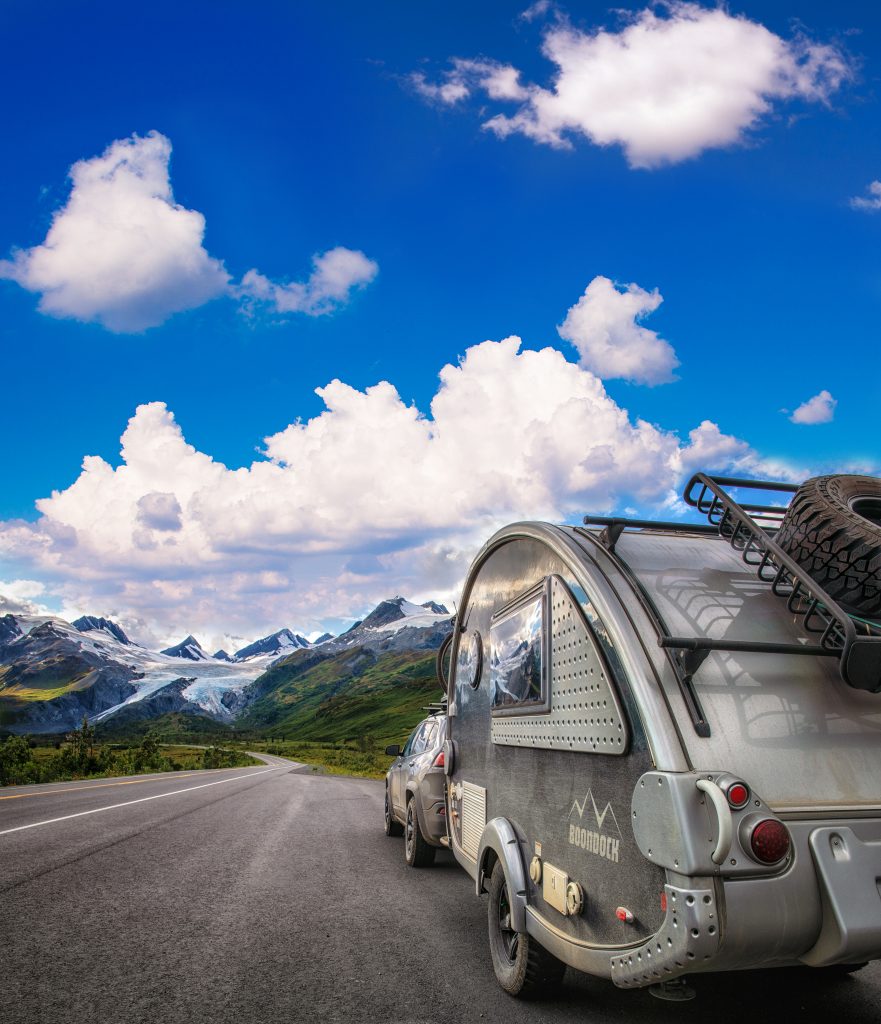Getting ready to head back out on the road with your camper? If it’s been stored for a few months, there are some housekeeping chores you’ll have to attend to before you hit the road. We’ve listed a few of the basic interior and exterior tasks to complete, but follow specific instructions listed in the manufacturer’s manual for your camper regarding propane and shore-power testing, de-winterizing your water system and other equipment and appliance checks.
Note: nuCamp recommends having the LP gas system undergo a leak test and LP gas operating pressure test by an authorized RV repair facility twice a year or after every long storage period.
Clean the Camper
You open your camper door and there it is—that slightly musty smell that means it’s time for a thorough detailing and airing-out. Even if you cleaned your camper before putting it into “hibernation” mode, it will still get that unused odor from being closed up for several months.
Open the windows, ceiling vent and door, turn on the exhaust fan, and let the fresh air in while you do a good wipe-down of the interior. (Tip: read your owner’s manual for any guidelines on what to use on specific surfaces.)
Open all the drawers, cabinets and cubbies, empty them of anything left behind and clean the interior and exterior, checking for any rodents or creepy-crawlies that hung out during the winter. If you do spot any signs, that means you have one or more access points that they have found, so keep an eye out for those and seal them with caulk or other appropriate sealants.
What else needs cleaning? Walls, ceiling, bench seats, light fixtures, shelves—basically anything that could have picked up dust, dirt or other contaminants. Since the kitchen and bathroom get a lot of use, make sure both are spic-and-span. This is also a good time to give the plumbing connections and valves a good once-over, looking for signs of leaks or corrosion.
Speaking of water, be sure to look up as well as down since water leaks can come from Mother Nature as well as man-made sources! Any discoloration on the ceilings or panels could indicate a water issue.
Finally, wash the bedding, linens, curtains and furniture coverings, scrub windows and screens (inside and out), and wipe down the blinds. Then wash the floor and/or carpeting, taking note of any signs that indicate wear-and-tear or water damage.
The inside is done—now for the outside. Give your RV a complete inspection from top (i.e., the roof) to bottom (i.e., the underside), looking for any damage: cracked vent covers, cracks in the caulking, damaged seams, missing sealant or openings that shouldn’t be there. (A mouse can get through a hole the size of a dime and a rat through one the size of a nickel, according to Modern Pest.)
Check the silicone around windows and doors, and if you have a side room, check the rubber wiper seals and bubble gaskets. Replace and repair any areas as needed, allow drying time as required and then move onto the wash-down phase. (Camping World recommends using a gentle biodegradable soap solution like Simply Green.) Open the awning and clean both sides with a soft bristle brush to remove any dirt or mildew, then rinse well and let it fully dry before retracting.
This is also a good time to lubricate your stabilizer jacks and tongue latch so everything runs smoothly. Now, with the cleaning done, it’s time for a systems-and-equipment check.
Evaluate The Equipment
Again, follow the instructions for all appliances, the water heater and plumbing system for verifying its operation status and any de-winterizing or flushing that needs to be undertaken. If you’re not sure what to check, take it to an authorized RV service facility for check and any needed maintenance.
Basically, you want to make sure that your appliances are ready to run on both the electric and propane settings, that your propane system and tanks are full and in good working condition, and that your water tanks and water system is ready to run with no leaks. If your camper is equipped with the Alde Hydronic Heating System, check the glycol fluid level in the expansion tank to make sure it is at least one inch above the minimum line. This may need to be topped off after first use.
Note: ALWAYS shut everything off when testing your propane system. If you don’t feel comfortable checking it, take it to an authorized dealer or RV repair center.
Then move onto the RV itself, following the manufacturer’s instructions for what to check and when to replace specific components.
If the battery wasn’t on a trickle charger during the off-season, it will need to be charged since they can lose up to 10% a month. Give it a good visual check for signs of corrosion or cracking, then put the battery on a charger and let it charge overnight, says RV Like a Pro. Still no power? It might be time to get a new one. (If it does need cleaning or you don’t trust your inspection smarts, let the pros handle it.)
Once it’s charged, check the battery fluid levels and add distilled water as needed. Note: Absorbent Glass Mat (AGM) batteries do not need water levels checked. Water should only be added to lead-acid batteries after they are fully charged.
While we’re on the subject of batteries and all things power, replace the batteries in your smoke and CO detectors, then make sure your fire extinguisher is fully charged and ready.
If you have a generator, review your manual for what to check, service and test. Camping World recommends checking the generator’s air filter for insect nests and general condition in case it needs to be replaced. After checking the exhaust system for any damage, KOA recommends you run it about two hours with at least a half-rated load (check the manual for load ratings) and, if it won’t start or continues to surge after starting, have it checked out and fixed by an authorized service facility.
Then, check the condition of sewage dump hose and the seals on waste tank valves to avoid any nasty surprises when you’re at a dump station. From there, move onto the tires, including the spare, first doing a visual inspection for cracks and tread depth, then checking for proper inflation, using the tire manufacturer’s load and inflation tables for proper inflation pressure, says KOA. (Again, get expert help if you don’t trust your knowledge.)
Last but not least, check the brake and signal lights, the antenna, and any other equipment.
Prepare Your Paperwork
Check that all needed paperwork is in order, up-to-date and accessible. This includes registration, insurance, and vehicle emissions sticker, as well as any public land passes such as US forest service pass, trail passes, and so on.
This is also a good time to put together an emergency information packet for each member of your RV party, including medical information and emergency contacts. (Tip: Don’t have just each other as emergency contacts if you’re traveling together.)
Now that your RV is ready to hit the road, pack up your food, clothes, supplies, and head out!
Check out the following YouTube Videos:
- RV Tips – How to de-winterize your trailer
- How To Dewinterize Your RV. Get Your RV Ready For The Camping Season
- How To De-Winterize Your RV
Recent Articles





